 |

|
 Timing is Everything
By Joe Levine
The history of man for the nine months preceding his birth would probably be far more interesting, and contain events of greater moment, than all the
three score and ten years that follow it.—Samuel T. Coleridge
When Coleridge penned those words more than a hundred and fifty years ago,
neither he nor scientists of his day knew just how right he was. Why? Because they didn't know,
as we do now, that every living being carries within it evidence of more than 3.5 billion years
of evolutionary change and adaptation by its ancestors. And it just so happens that much of the
evidence we humans carry is most obvious—to the eye, at least—during the stages of life
that take place inside the womb. So if you watch developing embryos through the lens of evolutionary
biology, they can carry you on even more amazing journeys—outward to the odyssey of life's
history, and inward, into the invisible world of genes.
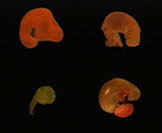 Ernst von Haeckel, an early champion of evolutionary theory, was the
best-known scientist to propose that similarities among embryos contain
important information. Specifically, Haeckel proposed that "ontogeny
recapitulates phylogeny." This pithy bit of jargon, when translated into
English, asserts that as an embryo develops, it passes through stages that
are equivalent to the adult forms of its ancestors. For example, according to
Haeckel, a human embryo would pass through a stage in which it has features
of an adult fish, then features of an adult amphibian, and so forth. Ernst von Haeckel, an early champion of evolutionary theory, was the
best-known scientist to propose that similarities among embryos contain
important information. Specifically, Haeckel proposed that "ontogeny
recapitulates phylogeny." This pithy bit of jargon, when translated into
English, asserts that as an embryo develops, it passes through stages that
are equivalent to the adult forms of its ancestors. For example, according to
Haeckel, a human embryo would pass through a stage in which it has features
of an adult fish, then features of an adult amphibian, and so forth.
That would be a mighty tall order, of course, for at least two reasons.
First, many adult animals (including extinct species) are highly specialized,
and carry scores of complicated structures that would have to be assembled
and disassembled as an embryo progresses from one stage to another. Second, any
species alive today has an awful lot of ancestors that stretch back over
billions of years. To pass through the adult stages of all of them would make
for a long, tortuous (and wasteful) embryonic life!
Biologists have known for decades that ontogeny doesn't strictly
recapitulate phylogeny—at least not in the precise way that Haeckel
thought it did. Haeckel was wrong in his insistence that embryos resemble
ancestral adults. But many embryos do pass through stages during which they
look a lot like embryos of their ancestors—and therefore, embryos of
related species. And many scientists agree that events during development are vitally important in evolution. Leigh von Valen, a prominent modern
evolutionary thinker, went so far as to suggest that " .. evolution is the
control of development by ecology." The subject is fascinating, complicated,
and not at all easy to summarize. (Stephen Jay Gould devoted several years
and a lengthy book to the topic.) But here are a
few important points to think about.
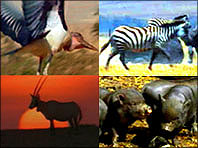 The embryos (fishes, birds, pigs and humans) in NOVA's "Odyssey of Life - The Ultimate Journey"
resemble each other because they all belong to animals that biologists call vertebrates. Any textbook
can tell you that, but what does grouping us together that way actually mean? The simple answer is
that we all share common ancestors who evolved a successful body plan based on a backbone, two pairs
of limbs, and body systems set up in a certain basic manner. But what does that mean? And what does
it have to do with the importance of embryos in evolution? The embryos (fishes, birds, pigs and humans) in NOVA's "Odyssey of Life - The Ultimate Journey"
resemble each other because they all belong to animals that biologists call vertebrates. Any textbook
can tell you that, but what does grouping us together that way actually mean? The simple answer is
that we all share common ancestors who evolved a successful body plan based on a backbone, two pairs
of limbs, and body systems set up in a certain basic manner. But what does that mean? And what does
it have to do with the importance of embryos in evolution?
Think about it this way. Each major animal group has evolved a unique combination of particular body-parts that perform essential functions. Take, for example, the fact that all animals must breathe. Many land animals use lungs like ours, but insects and spiders use quite different devices. Some
aquatic animals use various styles of gills, while others just let oxygen and
carbon dioxide pass across soft, wet skin. You can think of lungs, gills, and
other body parts that help animals breathe as the "breathing tool" component
of their body-part kits. There are similar "tools" for feeding, movement,
defense, reproduction, and so on.
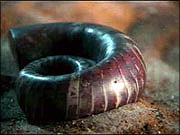 The intriguing point is that among all the millions of animal species alive today, there are only a couple of dozen really different body-part tool kits. Each is the hallmark of a major animal group—a collection of related
species that biologists usually call a Phylum. Mollusks—snails, clams,
octopi and their kin—are one such group. Insects and their relatives are
another. But with only two dozen or so basic body plans, where do the many
thousands of species within each group come from? You can think of each
group's basic body plan as the biological equivalent of a major musical
theme. The slightly different body plans of species within each group are
like variations on that theme. Just where do these themes and variations come from? Here's where things get interesting. The intriguing point is that among all the millions of animal species alive today, there are only a couple of dozen really different body-part tool kits. Each is the hallmark of a major animal group—a collection of related
species that biologists usually call a Phylum. Mollusks—snails, clams,
octopi and their kin—are one such group. Insects and their relatives are
another. But with only two dozen or so basic body plans, where do the many
thousands of species within each group come from? You can think of each
group's basic body plan as the biological equivalent of a major musical
theme. The slightly different body plans of species within each group are
like variations on that theme. Just where do these themes and variations come from? Here's where things get interesting.
An embryo grows and develops under the control of its genes. Some genes work
fairly simply, directing cells to churn out products and assemble those products
into structures. But these relatively simple genes couldn't produce a complex organism
by themselves. Their actions are coordinated by master control genes that act like orchestra
conductors—determining which genes are turned on and which are turned off, in what cells,
at what stages in development, and for what lengths of time. Of course, the task of
orchestrating the entire process of constructing a fish, pig, or human makes
directing the most complex musical score look like playing with nursery
rhymes!
This is one reason why entirely new basic body plans don't evolve very
often. Each body-part is assembled by a group of genes acting under the
direction of particular control genes. Those control genes are themselves
controlled by higher level control genes. And those genes are controlled
by still higher-level control genes. (In some ways, these controls-within-controls are set
up almost like a military chain of command.) The long and the short of it is that making
major changes in body-part tool kits requires wholesale shakeups in these complex genetic
programs. And in order to survive the test of natural selection, these shake ups need to happen
in ways that don't introduce any fatal flaws.
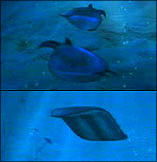 So it isn't surprising that completely new body plans haven't evolved very often. In
fact, these sorts of shakeups have occurred only a few times in the entire 3.5 billion
year history of life. The best-known was the "Cambrian
Explosion"—a period roughly 600 million years ago during which the basic
body plans of most major groups of living organisms (and those of many
extinct groups) arose. Of course, those original body plans were controlled
by genetic programs that have been passed down over time to species alive
today. So it isn't surprising that completely new body plans haven't evolved very often. In
fact, these sorts of shakeups have occurred only a few times in the entire 3.5 billion
year history of life. The best-known was the "Cambrian
Explosion"—a period roughly 600 million years ago during which the basic
body plans of most major groups of living organisms (and those of many
extinct groups) arose. Of course, those original body plans were controlled
by genetic programs that have been passed down over time to species alive
today.
How does all this explain why vertebrates pass through an early stage that
resembles a fish embryo? As Nietzsche once wrote, "Ye have made your way from the worm to man,
and much within you is still worm." Our "fish-like" early stages are directed by parts of the
same genetic program that built early fishes—some of the first members of our branch of the
animal kingdom. By the time fishes evolved, genetic control of development was already a very
complicated business, because fishes are complex animals. And once a genetic program passes a
certain level of complexity, it becomes difficult for major changes early on not to have "domino
effects" that knock things out of kilter down the line.
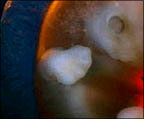 So, over millions of years, evolution operated mainly by
adding on to and fiddling around with later stages in development, rather
than by making radical changes in genetic programs that substituted one type
of body part for another. The result is that some aspects of the earliest
stages in the human developmental program remain rather similar to those
found in living fishes. So, over millions of years, evolution operated mainly by
adding on to and fiddling around with later stages in development, rather
than by making radical changes in genetic programs that substituted one type
of body part for another. The result is that some aspects of the earliest
stages in the human developmental program remain rather similar to those
found in living fishes.
 It is even more fascinating, however, to realize that minor modifications in the
timing and ordering of events during embryonic life can produce enormous differences in
adults. In fact, nearly all the sorts of evolutionary changes most of us usually think
about—ancient fishes giving rise to amphibians, amphibians to reptiles, dinosaurs to
birds, and so on—have occurred through relatively small changes in timing and orchestration
of genetic controls during development. That's how ancient limbs evolved into wings, or
feet into flippers. It is also how ape-like ancestors evolved into humans. Why do humans
share an astonishing 98% of our genes with chimpanzees? Because, when it comes to differences
between such closely related species, timing is everything! It is even more fascinating, however, to realize that minor modifications in the
timing and ordering of events during embryonic life can produce enormous differences in
adults. In fact, nearly all the sorts of evolutionary changes most of us usually think
about—ancient fishes giving rise to amphibians, amphibians to reptiles, dinosaurs to
birds, and so on—have occurred through relatively small changes in timing and orchestration
of genetic controls during development. That's how ancient limbs evolved into wings, or
feet into flippers. It is also how ape-like ancestors evolved into humans. Why do humans
share an astonishing 98% of our genes with chimpanzees? Because, when it comes to differences
between such closely related species, timing is everything!
Joe Levine is a biologist, educator, and science journalist. He is the author
of six books and numerous articles on scientific subjects, and the co-author
(with Kenneth Miller) of two widely acclaimed biology textbooks for high school and college students.
Related Books and Websites
Odyssey Home | How? | Morphing | Lens
Timing | Creepy Crawlies | Table of Contents
|
|
|